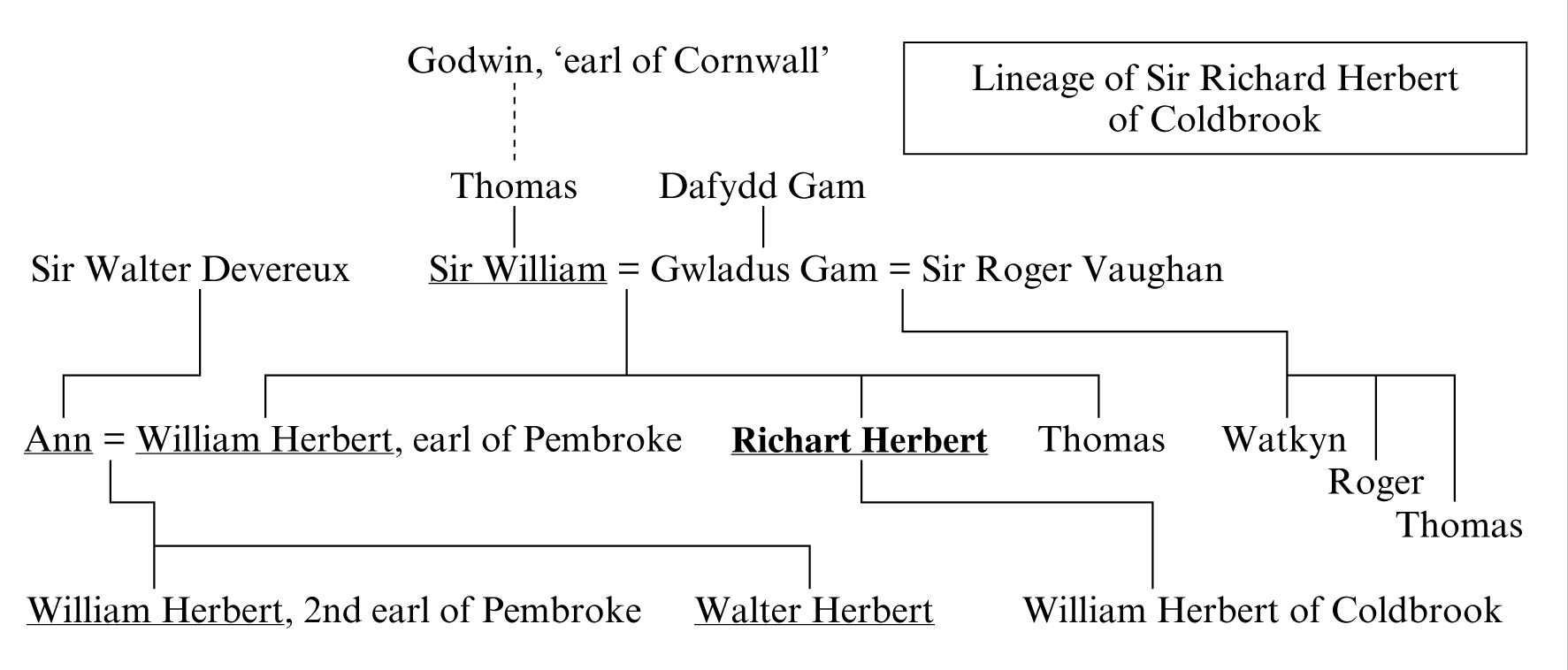Sir Richard Herbert was a notable patron, although only one poem for him by Guto’r Glyn survives (poem 22). There is an ode by Lewys Glyn Cothi (GLGC poem 113), a praise poem by Ieuan Deulwyn (Lewis 1982: poem 26) and an ode by Huw Cae Llwyd for his son, Sir William Herbert of Coldbrook, which may have been composed while Richard was still alive (HCLl poem 2). There is also a bardic debate between Ieuan Deulwyn and Bedo Brwynllys which was held in Richard’s home, Coldbrook (Lewis 1982: poems 28 and 29). Finally, there are elegies for him by Bedo Brwynllys (Lewis 1982: poem 30) and Hywel Dafi (Lewis 1982: poem 31) and a joint elegy for him and his brother William, earl of Pembroke, by Huw Cae Llwyd (HCLl poem 4).
Lineage
The genealogical table below was based on WG1 ‘Godwin’ 8; WG2 ‘Godwin’ 8B1. The names of Guto’s patrons are underlined.

Lineage of Sir Richard Herbert of Coldbrook
Richard was the second legitimate son of Sir William ap Thomas of Raglan and his second wife, Gwladus daughter of Dafydd Gam of Brecon. His elder brother was William Herbert, first earl of Pembroke (d. 1469). His wife was Margaret daughter of Thomas ap Gruffudd ap Nicolas (Griffiths 1972: 116). He left sons, Sir William Herbert of Coldbrook among others. Furthermore, he was a half-brother to the sons of Sir Roger Vaughan.
His home
He lived at Coldbrook, a house to the south-east of Abergavenny, now in Monmouthshire (SO 3112; Thomas 1994: 85). There is an extended description of the house in poem 22, and it is clear that Sir Richard spent lavishly on improving it. Unfortunately, the house was demolished in the year 1954 and now only the park remains to show where it stood (Smith 1957).
His career
Sir Richard Herbert appears mostly as a companion and supporter of his brother William, first earl of Pembroke. He received a pardon in 1457 at the same time as his brother (Thomas 1994: 85). That suggests that he had been supporting William Herbert in the contest between Herbert’s patron, Richard, duke of York, and the party of King Henry VI. Thomas (ibid.) notes that Richard fought beside his brother at the battle of Mortimer’s Cross, where the army of Jasper Tudor was defeated by Edward, the son of the duke of York. After Edward was acclaimed king, Richard appears often with his brother, fulfilling important roles in south Wales. He was, for instance, joint leader of the expedition against Carreg Cennen castle in 1462. The castle was held against Edward IV by Thomas and Owain ap Gruffudd ap Nicolas, but by May 1462 they were compelled to surrender it to Richard Herbert (Griffiths 1993: 28). Richard acted as deputy to his brother in his role as justiciar of South Wales in 1464 and 1466. He was escheator of Carmarthenshire and Cardiganshire in 1461–9 and constable of Cardigan from 1463 (Thomas 1994: 86). He also held offices in the lordship of Newport, which was under his brother’s control (ibid.). When William Herbert’s power extended into north Wales, Richard followed. In 1468 he led one of the three divisions of William Herbert’s army which went to seize Harlech castle, held by the Lancastrians. On the way there he defeated a force led by Jasper Tudor near the town of Denbigh (Ross 1974: 114). Like his brother, Richard Herbert was generously rewarded by the king; the lands which he received, many of them in Herefordshire and Gloucestershire, are listed in Thomas (1994: 86).
His death
For the circumstances, see William Herbert, first earl of Pembroke. Richard and his brother were taken prisoner at the battle of Edgecote on 24 July 1469 by the supporters of his enemy, Richard Neville, earl of Warwick. They were taken to Northampton and executed. The Welsh poets inform us that Richard was killed the day before his brother, i.e. on 26 July (Lewis 2011: 108–9). His body was taken back to Abergavenny and buried at St Mary’s Priory. His splendid tomb is still to be seen there.
Bibliography
Griffiths, R.A. (1972), The Principality of Wales in the Later Middle Ages: The Structure and Personnel of Government, i: South Wales, 1277–1536 (Cardiff)
Griffiths, R.A. (1993), Sir Rhys ap Thomas and his Family: A Study in the Wars of the Roses and Early Tudor Politics (Cardiff)
Lewis, B.J. (2011), ‘The Battle of Edgecote or Banbury (1469) through the Eyes of Contemporary Welsh Poets’, Journal of Medieval Military History, 9: 97–117
Lewis, W.G. (1982), ‘Astudiaeth o Ganu’r Beirdd i’r Herbertiaid hyd Ddechrau’r Unfed Ganrif ar Bymtheg’ (Ph.D. Cymru [Bangor])
Ross, C. (1974), Edward IV (Berkeley)
Smith, P. (1957), ‘Coldbrook House’, Arch Camb cvi: 64–71
Thomas, D.H. (1994), The Herberts of Raglan and the Battle of Edgecote 1469 (Enfield)





